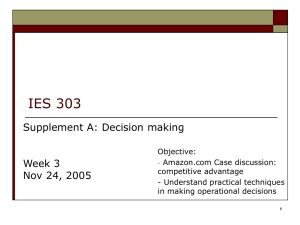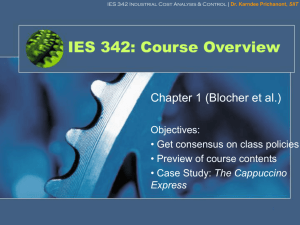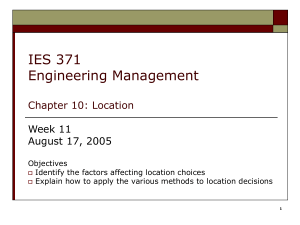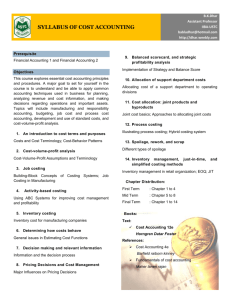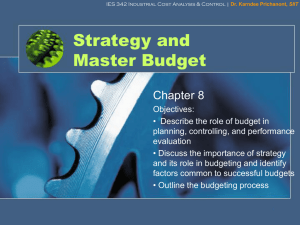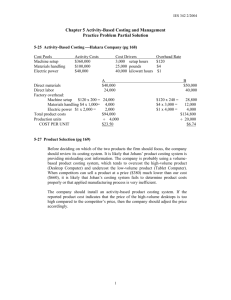Process Costing Systems Chapter 14
advertisement
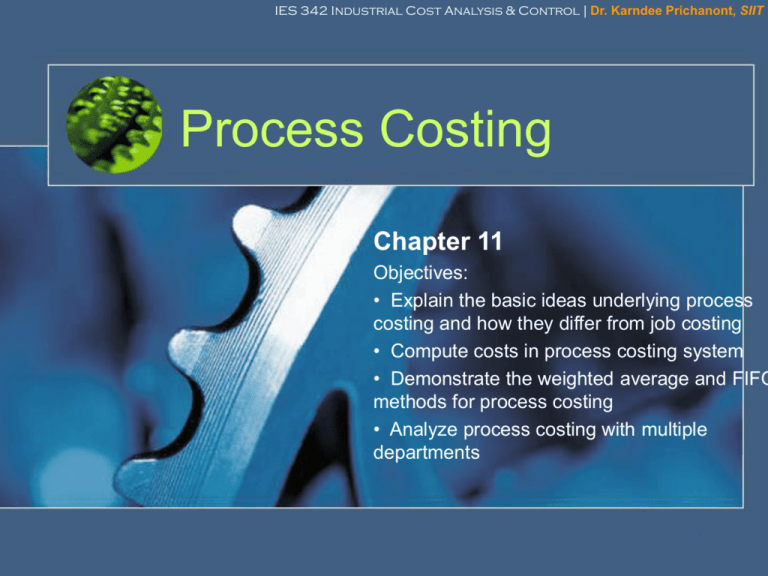
IES 342 Industrial Cost Analysis & Control | Dr. Karndee Prichanont, SIIT Process Costing Chapter 11 Objectives: • Explain the basic ideas underlying process costing and how they differ from job costing • Compute costs in process costing system • Demonstrate the weighted average and FIFO methods for process costing • Analyze process costing with multiple departments 1 IES 342 Industrial Cost Analysis & Control | Dr. Karndee Prichanont, SIIT Type of Business Using Process Costing __________ __________ __________ __________ __________ __________ __________ __________ __________ 2 IES 342 Industrial Cost Analysis & Control | Dr. Karndee Prichanont, SIIT Comparing Job Costing vs Process Costing Job costing Process costing Costs accumulated by the job. Work in process has a job cost record for each job. Many unique jobs. Jobs built to customer order. Costs accumulated by department or process. Work in process has a production report for each batch of products. Homogenous products. Units continuously produced for inventory in automated process. Same objective: _________________________ Same inventory account: _________________________ Same OH assignment method: _________________________ 3 IES 342 Industrial Cost Analysis & Control | Dr. Karndee Prichanont, SIIT Comparing Job Costing vs Process Costing Job Costing Direct Materials Direct Labor Finished Goods Factory Overhead Cost of Goods Sold 4 IES 342 Industrial Cost Analysis & Control | Dr. Karndee Prichanont, SIIT Comparing Job Costing vs Process Costing Process Costing Finished Goods Cost of Goods Sold 5 IES 342 Industrial Cost Analysis & Control | Dr. Karndee Prichanont, SIIT Dollar Amount Dollar Amount Characteristics of Process Costing Direct Direct Materials Materials Conversion Factory Overhead ____________ ____________ ____________ ____________ Direct Labor Type Product Cost Type ofof Product Cost So, direct labor and factory overhead are often combined into one product cost called _______________. 6 IES 342 Industrial Cost Analysis & Control | Dr. Karndee Prichanont, SIIT Characteristics of Process Costing Process costing accumulates costs by process or department and then assigns them to a large number of nearly identical products. Continuous mass production unit cost Similar processes Homogeneous products 7 IES 342 Industrial Cost Analysis & Control | Dr. Karndee Prichanont, SIIT Equivalent Units Equivalent units is a concept expressing partially complete units as a smaller number of fully complete units. Cost per equivalent unit • • • Manufacturing costs for a period Equivalent units for the period = We want to find the unit cost of performing a certain process in a given period, but 1 A manufacturing firm typically has partially completed units at the end of an accounting period Equivalent units Physical Units + = Two one-half filled cups are equivalent to one full cup. 8 IES 342 Industrial Cost Analysis & Control | Dr. Karndee Prichanont, SIIT Equivalent Units During its first month of business, Jones started 15,000 units and completed 10,000 units, leaving 5,000 units in process 30 percent complete. How many equivalent units of production did Jones have for the month? a. 10,000 b. 11,500 c. 13,500 d. 15,000 Now assume that Jones incurred $27,600 in production costs. What was Jones’ cost per equivalent unit for the period? a. $1.84 b. $2.40 c. $2.76 d. $2.90 9 IES 342 Industrial Cost Analysis & Control | Dr. Karndee Prichanont, SIIT Flow of Costs in Process Costing • Costs flow through different processes or departments • Use separate WIP Inventory account for each department • DM, DL, OH costs can be entered directly into either production department’s WIP Inventory account, not just the first department • Transfer of costs from a department subsequent departments FG Inventory Cost of goods sold • Transfer-in-costs (TI): costs of goods completed in the prior department and transferred into the department during the period 10 IES 342 Industrial Cost Analysis & Control | Dr. Karndee Prichanont, SIIT 5 Steps in Process Costing Analyze the physical flow of physical units. ________ ________ ________ ________ ________ ________ Calculate equivalent units of production for all manufacturing cost elements. Determine total cost for each manufacturing cost element. Compute cost per equivalent unit for each manufacturing cost element. Assign the total manufacturing costs to units completed and units of work in process at the end of the period. 11 IES 342 Industrial Cost Analysis & Control | Dr. Karndee Prichanont, SIIT Process Costing Method Weighted-Average Method • __________________ __________________ __________________ __________________ • Blends together units and costs in beginning inventory with units and costs in the current period. FIFO Method • __________________ __________________ __________________ • Assumes units in beginning work in process inventory are completed and transferred first. 12 IES 342 Industrial Cost Analysis & Control | Dr. Karndee Prichanont, SIIT Weighted Average vs FIFO Which one is better? FIFO costing results in a current period cost that can be used for performance evaluation. If there is no beginning inventory (JIT) or if beginning inventory is small, FIFO and weighted-average produce the same results. 13 IES 342 Industrial Cost Analysis & Control | Dr. Karndee Prichanont, SIIT Ex 1: Basic Process Costing (No Beginning Inventory) Adapted from Horngren et al. (2002) page 587 • XYC Inc. produces portable CD players in large quantities. Assume that the company has two departments, assembly and testing. The manufacturing costs in Assembly Dept during February were: DM added DL OH • $60,800 $50,000 $40,000 Assume no beginning inventory of WIP. Suppose work on 19,000 CD players was begun in the assembly department during February, but only 17,000 CD players were fully completed. All the parts had been made or placed in process, but only half the labor had been completed for each of the CD players still in process • Compute the costs of units completed and transferred to the Testing Dept and the cost of ending WIP. 14 IES 342 Industrial Cost Analysis & Control | Dr. Karndee Prichanont, SIIT Ex 2: Process Costing (with beginning inventory; use weighted-Average) Adapted from Horngren et al. (2002) page 587 • ABC Inc. manufactures electric drills. Material is introduced at the beginning of the process in the Assembly Department. Conversion costs are applied uniformly throughout the process. As the process in completed, goods are immediately transferred to Finishing Dept. • Data for the Assembly Dept for the July 20X1: •WIP, June 30: $175,500 ………………………………….. 10,000 units ($138,000 materials and $37,500 conversion costs); completed for DM but only 25% completed for conversion costs •Units started during July ………………………………….. 80,000 units •Units completed during July ……………………………... 70,000 units •WIP, July 31: 100% completed for DM, but only 50% completed for conversion costs ………………………………………….…. 20,000 units •DM added during July………………………………………….. $852,000 •Conversion costs added during July …………………………$634,500 15 IES 342 Industrial Cost Analysis & Control | Dr. Karndee Prichanont, SIIT Process Costing with Multiple Departments Multiple departments in a process result in units and costs that are transferred from a prior department to the current department. These transferred-in costs are treated exactly like a direct material that is added at the beginning of a production process. 16 IES 342 Industrial Cost Analysis & Control | Dr. Karndee Prichanont, SIIT Ex 3: Process Costing with Transferred In Costs Deparment Costs Units Physical flow: Beginning inventory Ending inventory Unit started (transferred in) Started and completed Costs incurred: Beginning inventory Current Costs Prior Direct Conversion Departme Costs Materials nt's Costs 100% 100% 100% 100% 2000 4000 12000 8000 $ $ 40% 25% 80% 60% 100% 100% 5,000 $ 2,000 $ 52,000 $ 20,000 $ 1,000 7,000 17


